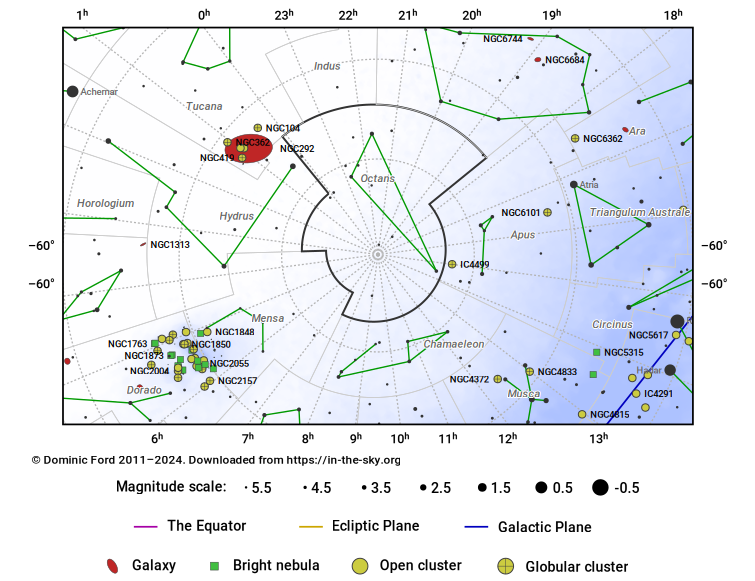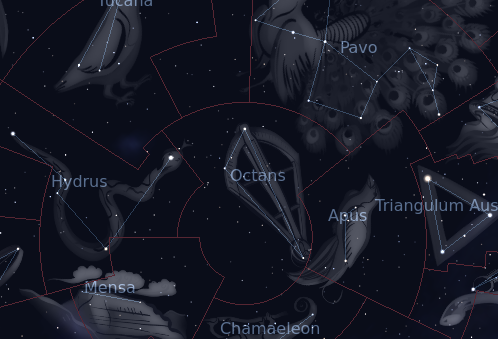The Constellation Octans
Octans is a faint constellation in the southern sky, most notable for containing the south celestial pole.
Whereas the north celestial pole lies close to the pole star Polaris, the south celestial pole lies in a dark area of the sky. Octans contains only one star brighter than fourth magnitude, and there are no stars visible to the naked eye within a degree of the pole.
Octans is named after the octant, a compact form of quadrant used for measuring the angles between stars. The name was applied to this sky area by Nicolas Louis de Lacaille in 1756, as one of fourteen constellations which celebrate tools.
Lying away from the plane of the Milky Way, Octans contains no bright deep sky objects.
Hover the pointer over the name of an object to highlight its position on the starchart to the right, or click to see more information.
| Stars | Open Clusters | Globular Clusters | Galaxies |
| ν-Oct (mag 3.7) | NGC 7098 (mag 11.5) | ||
| β-Oct (mag 4.1) | NGC 6438 (mag 11.6) | ||
| δ-Oct (mag 4.3) | NGC 7095 (mag 11.9) | ||
| θ-Oct (mag 4.8) | NGC 6920 (mag 12.0) | ||
| γ¹-Oct (mag 5.1) | NGC 7637 (mag 13.2) | ||
| α-Oct (mag 5.1) | NGC 2573 (mag 13.5) | ||
| ε-Oct (mag 5.2) | IC 4864 (mag 13.6) | ||
| χ-Oct (mag 5.3) | NGC 6557 (mag 14.0) | ||
| γ³-Oct (mag 5.3) | IC 4333 (mag 14.8) | ||
| ξ-Oct (mag 5.3) | IC 5040 (mag 15.2) | ||
| ζ-Oct (mag 5.4) | IC 5025 (mag 15.4) | ||
| σ-Oct (mag 5.4) | IC 5022 (mag 15.5) | ||
| φ-Oct (mag 5.5) | IC 5026 (mag 15.5) | ||
| λ-Oct (mag 5.5) | IC 4912 (mag 15.6) | ||
| ψ-Oct (mag 5.5) | IC 4928 (mag 16.0) | ||
| τ-Oct (mag 5.5) | |||
| ι-Oct (mag 5.5) | |||
| κ-Oct (mag 5.6) | |||
| ρ-Oct (mag 5.6) | |||
| π¹-Oct (mag 5.6) | |||
| π²-Oct (mag 5.7) | |||
| HIP 7568 (mag 5.7) | |||
| γ²-Oct (mag 5.7) | |||
| HIP 117125 (mag 5.7) | |||
| υ-Oct (mag 5.8) | |||
| HIP 101427 (mag 5.8) | |||
| HIP 1074 (mag 5.8) | |||
| HIP 116250 (mag 5.8) | |||
| ω-Oct (mag 5.9) | |||
| HIP 7601 (mag 5.9) |




